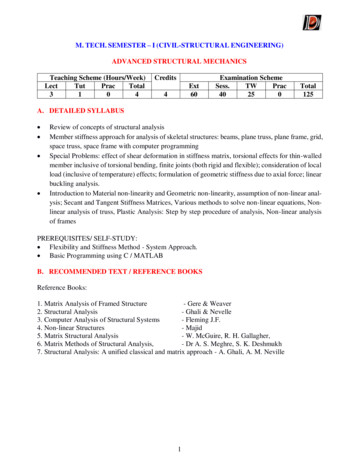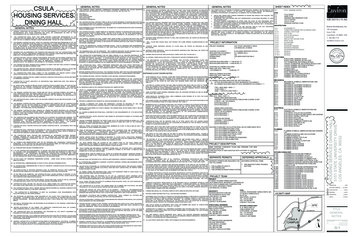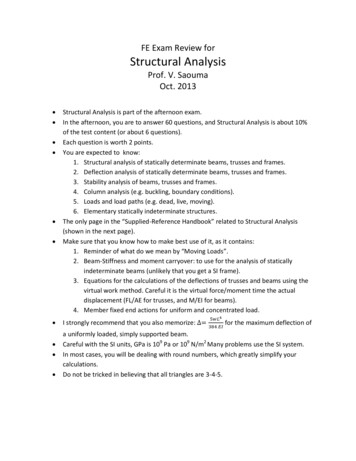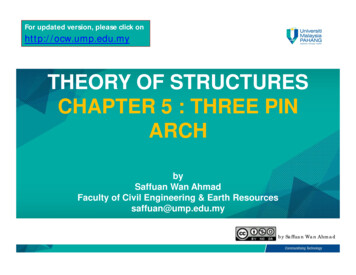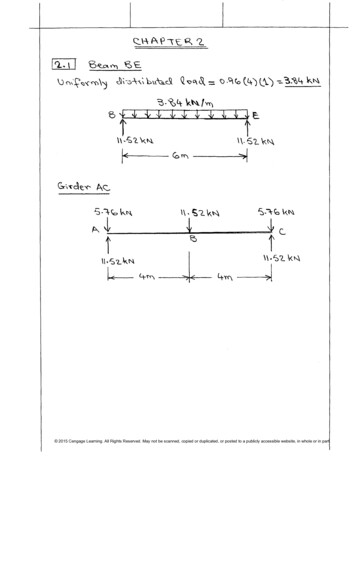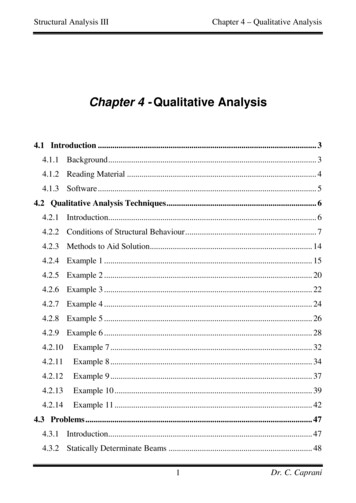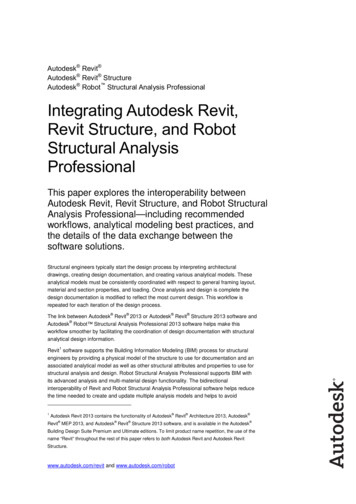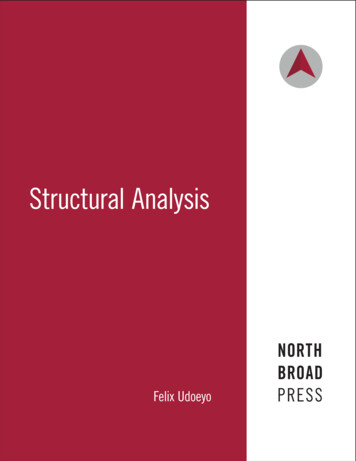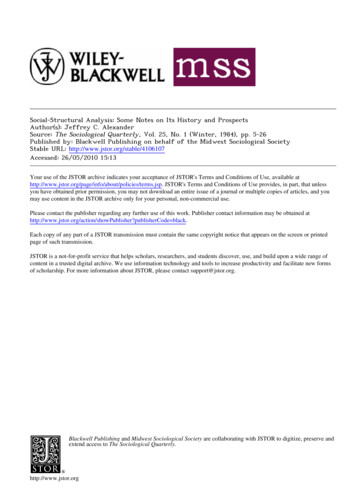
Transcription
Social-Structural Analysis: Some Notes on Its History and ProspectsAuthor(s): Jeffrey C. AlexanderSource: The Sociological Quarterly, Vol. 25, No. 1 (Winter, 1984), pp. 5-26Published by: Blackwell Publishing on behalf of the Midwest Sociological SocietyStable URL: http://www.jstor.org/stable/4106107Accessed: 26/05/2010 15:13Your use of the JSTOR archive indicates your acceptance of JSTOR's Terms and Conditions of Use, available rms.jsp. JSTOR's Terms and Conditions of Use provides, in part, that unlessyou have obtained prior permission, you may not download an entire issue of a journal or multiple copies of articles, and youmay use content in the JSTOR archive only for your personal, non-commercial use.Please contact the publisher regarding any further use of this work. Publisher contact information may be obtained herCode black.Each copy of any part of a JSTOR transmission must contain the same copyright notice that appears on the screen or printedpage of such transmission.JSTOR is a not-for-profit service that helps scholars, researchers, and students discover, use, and build upon a wide range ofcontent in a trusted digital archive. We use information technology and tools to increase productivity and facilitate new formsof scholarship. For more information about JSTOR, please contact support@jstor.org.Blackwell Publishing and Midwest Sociological Society are collaborating with JSTOR to digitize, preserve andextend access to The Sociological Quarterly.http://www.jstor.org
The Sociological Quarterly 25 (Winter oryandSomeProspectsJeffrey C. Alexander, University of California, Los AngelesSocial scientists have begun to move away from the postivist and empiricistmodels withinwhich they have traditionallyconductedtheir behavioralstudies.This change has been effected by the impact of historians of science (like Alexandre Koyre' and Thomas Kuhn) and philosophers of science (like MichaelPolanyi and Imre Lakatos) and by the impact, as well, of the disruptivesocialdevelopmentswhich destroyedthe ideological consensus of the postwarperiod.In the United States, however, this movement towarda postpositivistperspective is still very much confinedto a small minorityof social-sciencepractitioners.Indeed,it has been accompaniedby a movement among the majority in an opposite direction,an increasingly self-confidentscientism among the positivistsand empiricists themselves. Thus, while postpositivist sensitivity has been increasing, we have also witnessed the transformationof broad,intellectualorgansintospecializedoutletsfor "scientific sociology"-atheoretical exercises in verification, falsification,and theory"construction."Nonetheless,the minoritythat nowrejects positivismand empiricismis a vocal one, and it has had an increasingimpacton the variousdisciplines. This impact has coalesced aroundthe idea of "paradigm,"the concept whichKuhn(1962)introducedto indicatethe strongeffect that nonempiricalassumptions have on the very perception of empirical variables.This essay will investigate the impact of certain kinds of paradigmatic, orframing, elements on social science, specifically, the understandingthat actionis organizedby structural constraints that are, in some sense, external to anyparticular actor. In order to place this discussion in its proper perspective,however, we must deal briefly with certain analytic problems in the term"paradigm." There is, of course, an enormous literature on this issue; in thepresentcontext, I deal with it only as it relates to the particularproblemat hand.In his initial formulation,Kuhndefined a paradigm as a frameworkthat provides scientists with preprogrammedinformationthat reduces the normaltaskof empirical investigationto mundaneacts of atheoreticalproblemsolving. Theparadigm is a jigsaw puzzle in which most of the pieces are already in place;the scientist examines reality only to find out how the three or four remainingpieces shouldbe arranged.Yet, while apparentlystraightforward,this formulation actually obscures some important problems, problems which relate toKuhn's tendency to exaggerate the unity of science. While insisting thatparadigmsprovideready-madeframeworksfor research, Kuhnalso identifiedparadigms with general, metaphysical assumptions (like atomism or holism)and with particularkinds of models (like equilibriumor dynamic models). Heassociated "paradigms,"in otherwords,with bothvery generalandvery specific@ 1984by The SociologicalQuarterly.All rights reserved.0038-0253/84/1600-0005 00.75
6 THE SOCIOLOGICALQUARTERLYkinds of commitments, with philosophicalorientations,and with complex propositions attached to strongly developed research strategies.But if paradigms refer only to generalized orientations,they will not producethe kind of scientific consensus that Kuhnassumed, for there is a great rangeof variationin the way that general, philosophicalorientationscan be specified.On the other hand, if paradigms refer only to agreement on propositionsandresearch strategies-what Kuhnlater called "exemplars"-then much of therichness of the original formulationis lost (Alexander, 1982b):the excitementthat this seminal idea created was due, in large part, to the way it linked themetaphysical environment of science to changes in mundane research.Kuhn'soriginal formulationof paradigm, then, was undifferentiated.I amsuggesting, by contrast, that 'paradigms' contain a range of elements of different levels of generality. These elements, moreover, are not necessarily tiedclosely together.This issue, we must see, is directlyrelevantto the task at hand.Whenwe speak, for example, of rational-choicetheory, we are actually referring to a number of different levels of analysis. On one hand, we are speakingof general assumptions about actors-that they are efficient and rational. Onthe other hand, we are talking about concrete theories within which theseassumptionsare operationalized,theories which are associated with particularcarrier groups, rather than diffuse traditions--"the British utilitarians,""Simon's shop," "Skinner's research team," "Tilly's group," "resourcemobilizationtheory." Paradigms in social science operate forcefully at bothgeneral and specific levels of orientation. "Rational action," "normative action," and "social structure" function as philosophicalorientations, as broadtraditionsthat create the most general lines of divisionbetween differentkindsof social-scientific work. These traditions cross disciplinary lines, for theirassumptionsrefer to presuppositional,analytical problems, rather than to theempirical and ideological concerns that differentiate, for example, politicalscience and sociology. At the same time, these three orientationsare embodiedin operationalized"research programs" (for this term, see Lakatos, 1969),intheories that have highly elaborated,empirically specified worldviews: for example, neoclassical economics, organizationtheory, symbolic interactionism,Marxism, and structuralfunctionalism.For a discussionof structuralanalysisto be accurate and revealing, it must address itself to both the general andspecific dimensions of structural analysis.The Problems of Action and OrderThe most fundamentalassumptionsthat informany social-scientifictheoryconcern the nature of action and order (Alexander, 1982a:64-112).Every theory ofassumesanto the , "What is action?" Every theory contains an implicit understandingofmotivation. Is it efficient and rational, concerned primarily with objectivecalculation,or is it nonrationaland subjective, orientedtowardmoral concernsor altruism, strongly affected perhaps, by internal, emotional concerns? Theproblem of action is concerned, in other words, with epistemology, with therelative materialism and idealism of action. Action has vexed and dividedclassical thinkers from Plato and Aristotle to Augustine and Hobbes, and it con-
SocialStructuralAnalysis 7tinues to do so today. Modernsocial science was born from the 18thand 19thcentury struggles between Enlightenment rationalists and reactionary traditionalists, and later between romantics and utilitarians. This struggle was, toan importantdegree, a fight aboutwhether-and how-action was "rational."No intellectual tradition, however, can be groundedin conceptions of actionalone. Weare concernedhere with socialtheories, and every social theory mustalso be concerned about the problemof order. How is action arranged to formthe patternsand institutionsof everyday life? There have been two prototypicalanswersto this problemof order:the individualisticand the collectivistic.Societymay be viewed as the productof negotiation freely entered into, as the resultof individualdecisions,feelings, andwants. Onthe otherhand,we can view society as constituting,in Emile Durkheim'sfamous phrase, a reality sui generis,areality "in itself." Such a collectivist view does not have to posit society as ametaphysical entity that has an ontologicalstatus. It can simply see individualdecisionsas aggregatedthrougha long, historicalprocess: the decisionsof thosewho came before us have become sedimented into institutions.Whenwe makedecisions today, we can do so only withinthe context of this social environment.Every conceptionof order is necessarily informedby assumptions about action. If we adopt an individualistic approach, we must know whether thesenegotiating actors will evaluate one another in an objective or subjective way.If, by contrast, we conceive of order as rootedin the collectivity, we shall wantto knowwhetherit asserts itself by appealingto rationalinterestor by promotingfeelings of altruistic obligation. It is, of course, logically possible for theoriesto combine rational and nonrationalmodes of action; in practice, it is rare forthem to do so.Individualistictheorieshave been attractive to modernsocial science becausethey emphasizea qualitywhich is at the heart of modernityitself: voluntarism.Modernsocial thought emerged out of the long process of secularization andrebellionagainst the hierarchicalinstitutionsof traditionalsociety. During theRenaissance, Machiavelli emphasized the autonomy of the rational prince toremake his world. English-contract theorists (like Hobbes and Locke, fromwhom so much of contemporarythoughtis derived) also brokefree from traditional restraints by emphasizing the individual bargaining upon which socialorder must depend. The same kind of path was followed by some of the principal thinkersof the FrenchEnlightenment,whowere the first to transformthisnew, secular, social thoughtinto an attempt at empirically - oriented science.Each of these individualistictraditionswas strongly rationalistic. In differentways and with emphases on different kinds of individualneeds-power, happiness, pleasure, security-each portrayed society as emanating from thechoices of rationalactors. Today,these classical traditionshave many progeny.The crucial, conceptual bridge was utilitarianism, particularly classicaleconomics, for its theory of markets and resources provided an empiricallyelegant explanation of how individual decisions can be aggregated to form"societies." There is but a short step from the early Bethamite theories to theorganizationtreatises of Simon (1964),the exchange theories of Homans (1961),the collective decision-making theories of Coleman (1966), and the politicaltheories of Downes (1957).
8 THE SOCIOLOGICALQUARTERLYYet, despite their origins in the secular rebellionagainst traditionalthought,individualistictheories have also assumed a nonrationalform. In its inversionof the Enlightenment and its revulsion against utilitarianism, 19th-centuryromanticisminspiredtheoriesaboutthe passionateactor, for example, Wundt'ssocial-psychologicalwriting on the central role of emotionalneeds. Freud is themost famous modern exemplar of such romantic theorizing, and thepsychoanalyticperspective continuesto supply one of the fundamentalstrandsof individualisticthinkingaboutsociety. Another,less scientistic branchof thisantirationalistic movement issued in phenomenology,a movement which canbe traced from Hegel Schleiermacher, and Dilthey throughHusserl to modernmovements,like existentialism.In terms of the social-scientificparadigmswhichhave concretized this kind of individualisticapproach, one thinks first of symbolic interactionism, the tradition rooted in American pragmatism and individualism of Dewey, Mead, and Blumer; in more recent years, there are thetheoretical developments of ethnomethodology,which takes its immediate intellectual roots from Schutz and Heidegger.But if individualistic theories have the great advantage of embodying thefreedom which we associate with the modern age, this is also their greatweakness, for it seems that they have achieved voluntarism much too easily.Do actors really create social order by a process of purely individualnegotiation? This, indeed, seems like an extremely unlikely proposition.Considertheproblem of order and the rational actor. Are we really so rational that we canbe aware of all the influences and constraints that enter into our decisions? Wemight think, perhaps, that we are simply trying to drive the best bargain witha salesman for a new car, but is this negotiationcompletely unaffected by external factors-unaffected, for example, by the size and variety of the particulardealership, the oligopolisticstructureof the automobilemarket, or the government's regulation of production?These external factors, in turn, can be seenas the outcome of a vast range of other extra-individualfacts, from the speedof technological innovation to domestic political struggles over ecology andrevolutionaryupheavals in the MiddleEast. Ourindividualnegotiation, then,may appear to be confined to two parties, but it actually is constrained by awhole host of factors, which we, as individuals, have not negotiated at all. Ourdecision to buy an automobile,moreover, will create constraints for future actors: could any actor ever be so omnisicently rational as to follow out all theramifications of this individual choice?Thus far, my illustrations of individualisticapproaches have been confinedto rationalistic tradition; similar arguments, however can be made against individualism that takes a more nonrationalform. Considerthe actor as an emotional being who is conceived as dealing with the outside world in terms of personality needs. Is this personality his own, something he has developed purelyas the result of his individualacts or is it rather the productof a lifetime of interaction, something in which the needs, wishes, and intentionsof significantothers have become synthesized and internalized to form a self? Emotionallysensitiveactors, whileappearingto respondto one anothermerely as individuals,actually are responding in terms of their discreet histories of social development. The same might be said for interactionisttheories, like those of Goffman(1959),that stress the moral sensitivity of individualsto questions of face, pro-
Social Structural Analysis 9priety,and taste. Theseconcerns,after all, are forcefullyembodiedin standards.Certainly,individualsmay negotiate in relationshipto them; yet, the standardsthemselves are never established by the individual interaction.Whenwe closely examine the most conscientiousindividualistictheories, wesee, in fact, that they make assumptionsabout social structure that they do notexplicitly theorize: they leave these assumptions, rather, as un-thought-outresidual categories. Rational-choicetheories, for example, often assume a certain distributionof resources and a certain relationship of bargainers to oneanother; they assume, in other words, important facts about economic andpolitical structure.Homans' writings on exchange admitted that standards ofdistributive justice are critical, but he never explained how they come about.Coleman (1966)argued that collective structures can be seen as productsof rational cost accounting,but he acknowledgedthat the conflict so producedmustbe regulated by certain givens, like constitutions. Nonrational,individualistictheories place similar brackets aroundthe structuring of the symbolic world.Theyassume-without explaining-the aftereffectsof socialization,the resourcesof cultural symbolization,the norms that define the nature of social solidarity.Goffman (1961), for example, explained insanity as the product of the selfconceptionsof the professionalswho manage asylums; yet, the sources of professionalizationand the reasonsfor the existence of asylums were never discussed. Garfinkel's(1981)recentsearch for the ethnomethodologyof individualorientationto the collectivity also leaves the normativeorderof the collectivity unexamined. (For an analysis of the persistence of striking residual categories inindividualistic, nonrationaltheories, see Alexander, 1984a.)The realization that individualistictheories cannot and do not stand withoutsome reference to a collective order has always been the stimulus for socialtheory to move toward the perspective of social structure itself. Such a movement has occurredwithin boththe orientationsto action I have described. Hobbes (1962/1651:98)was the first great theorist of social structure within the rationalist tradition,for he recognizedthat if society were actually composedonly of rational and completely selfish individuals, it would soon be destroyed:"Andtherefore if any two men desire the same thing, which nevertheless theycannot both enjoy, they become enemies; and in the way to their end, whichis principally their own conservation, and sometimes their delectation only,endeavor to destroy, or subdue one another." Hobbesformulated a conceptionof an all-powerfulsovereign, the Leviathan,which wouldcounteract this imminent chaos of individualismthroughintimidationand hierarchical control.Theparallel for this breakthrough in the normative tradition can be found inDurkheim'scritique of Spencer, the 19th-centuryindividualisticsocial scientistDurkheimargued against Spencer'scontract theory in terms thatpar excellence.strongly recalled Hobbes'."If interest relates men," Durkheim(1933/1893:203)wrote, "it is never for more than some few moments . [and] each individualfinds himself in a state of war with every other." It was to counter such "provisory and precarious" contractual relations that Durkheim created his conceptionof the "collective conscience," the normativecenter of society that controls individualismby penetratingand socializingindividualconsciences. FromHobbes'Leviathanand from Durkheim'scollective conscience, every moderntheory of social structure can be logically derived.
10 THE SOCIOLOGICALQUARTERLYSocial-StructuralTheory in Its Instrumental FormThe revolt against individualistic,instrumentalexplanationin the 19thcenturyalways occurred for ideological as well as analytic reasons. The first greattheoriesthat placedrationalactionwithina collective contextwere those of Bentham and his utilitarian followers. Bentham (see Halevy, 1972/1901-04)sawthrough the facile assumption of the "natural identity of interest" by whichclassical political economy justified its purely individualistargument. Realizing that economic and political actors actually possess unequal power andwealth-and that consequently, no "invisible hand" would ever produce consensus and equilibrium-Bentham argued that government must act to reformulate the social context in which such action occurs. The identity of interests,if it were ever to be achieved, must be one that is artifically constructedby suchexternalforce. Benthamutilizedthis theoreticalargumentto suggest aggressivereforms of criminal law and state bureaucracy; there is a direct link betweenhis structural orientationand the social and historical theorizingabout the effects of the capitalist social structurewhichFabian writers producedat the endof the century.The greatest theorist of social structure in the instrumentalist tradition,however, was Marx. If his critique followed the general lines of Bentham's, itcarriedthe logic muchfurther;indeed,it translatedthe generalsocial-structuralargument into an empirically specific theory, or examplar, which, in one formor another,woulddominatethis strandof structuralthinkingthroughoutthe 20thcentury. Marx refuted the argument that society is the product of individualexchange. It is not simply a bargain between two individuals that determinesthe contract of labor, he wrote, or even the aggregation of individualdecisionsthroughan impersonalmarket. The labor contract, he insisted, was determined by a peculiarly coercive kindof social structure that issues from the concentrationof private wealth: capital. "Capital,"Marxwrote (1963/1844:85),"is thepower of commandover labor and its products. The capitalist possesses thispower, not on account of his personal or human qualities, but as the owner ofhis capital. His power is the purchasingpowerof his capital, which nothingcanwithstand."Social structure,in Marx's view, affects action by fixing in advanceits material environment.Since actors are rational, their behavior follows thestructureof this externalenvironment,just as responsefollowsstimulus.Marx'scapitalism is a tightly interdependentsystem within which economic exigencies set the pace. He specified the function of the economy as ever more efficient production,and it is these productivedemandsthat establishthe individualrole structure of capitalist society. The other institutionsin his system are thebourgeoisstate and ideology; yet, as "superstructures"they performtasks thatare subordinatein complex ways to the demandsof capital. Humanbeings enterthis social structure in their role as members of classes, groups of like-mindedindividuals who perform the same general kind of economic role tasks. Rolerelations reflect this systemic hierarchy: capitalists dominate proletariansasthe economic base dominates the superstructure.AlthoughMarx emphasizedsocial structureover voluntarynegotiation,he did not view his system in a staticway. To the contrary, capitalism is driven by contradictory, functional requirements, contradictions which produce a struggle for existence between
Social Structural Analysis 11workers and capitalists and, eventually, the transformationof the capitalistsystem itself.Marx set the tone for subsequentrationalisttheorizingaboutsocial structure,and even those who "secularized" his work by neutralizingits revolutionary,chiliastic spirit followedclosely his general logic. The greatest among these ambivalent secularizers, the man who has been called the "Marx of thebourgeoisie,"and the only 20th-centurythinkerwhose contributionsto the rationalisttraditionrankwith Marx'sown,was Max Weber.Althoughwe shall seein a followingsection that Weberalso made an effort to criticize instrumentalistthinking,his contributionsare as much to the Marxiantraditionas to any other.Weber carried Marx's approach to social structure from the economic intothe political realm, and he carved out independentstructures of stratificationand conflictwhich Marxhad never yis a coercive structureevery bit as powerfulas economicsystems.Bureaucracy responds to demands for administrative efficiency much aseconomicfactors like markets, factories, and contractsrespondto needs for productive efficiency. Bureaucratic roles, like economic ones, follow from thoseexternal demands: if capitalism demands competition and exploitation,bureaucracydemandsimpersonalityand rationality.Bureaucracycreates orderthroughpoliticaldominationfrom above and passive subordinationfrom below,a structure, once again, which follows the logic, if not the empirical context,of Marx'searlier model. If Webergave any functionalsystem dominance,it wasthe political sphere within which he discovered this bureaucraticforce. WhereMarxanalyzedprecapitalistsocieties in terms of their economicarrangements,Weber (1968:1006-11)defined feudalism as a system which created certaindistinctive political conflicts. Yet, Weberemphasized that social systems, particularly modernones, are never ruled by one form of external sanction alone.He (1946:180-95)describedthree hierarchicaldomains:class, status, and power.Each hierarchyof controlstructuresinstrumentalrewardsin a distinctiveway,and each is the scene of struggles for different kinds of power. Men can use asurplus in one kind of good, moreover, to increase their power by exchangingthis surplus for goods of another type. They can trade money for prestige, asthe nouveaurichedo when they train their offspring to enter the professions orthe arts. They can, on the other hand, exchange power for money, as corruptpoliticians and bureaucrats do when they enrich themselves throughpoliticaloffice. In each case, the motivation is an instrumentalone, but the bargainingproceeds within highly structured systems of stratification (for a recent veryrich empirical application, see Azarya, 1978).It is the theoretical legacies of Weber and Marx that have framed moderninstrumentalist explanations of social structure. Althougheach theory retainsits orthodoxadherents, there has more often been a more or less consciousmelding of the two. The most importantcontributionshave followedMarx andWeber in their concentration on economic and political systems and thesesystems' effects on role stratificationand conflict.Argumentsaboutthe economyhave focused on whether the functionalexigencies of capitalism have changed,and if they have, what new role structures and social conflicts result. There hasbeen general agreement that in its late stage, capitalism has shifted towardcapital-intensive production that involves more mental than physical labor, labor
12 THE SOCIOLOGICALQUARTERLYthat relies, in turn, increasingly upon education. On more specific levels,however, there has been vast disagreement about the shape that these new externalconditionstake (1) Is "capitalism"still a relevantway of describingtheseconditions? (2) If so, does propertyownershipcontinue to be decisive in structuringrole positionand conflict? (3) If not, what structures and forces remain?Because Goldthorpeand Lockwood(1963)argued that propertyownershipisstill primary for structuring economic roles, they could argue that the newis braced by anprivatism and individualism of ideological embourgeoismentideologicalcollectivism; this collectivismbecomes morewidespreadas the newly created classes are forced-because of their propertylessness-to enter thetrade-unionmovement. Baran and Sweezy (1966)agreed that economic production in western societies is "capitalist,"and they linkedthis capitalist characterto the external exigencies of private property. For them, however, ownershipand, indeed, wealth distributionbecome largely irrelevant; profit maximization andwastefulsurplusare the primary"structures"of later capitalistsociety,and they producesocial conflicton an (1974) elaborated these qualitative consequences, arguing thatcapitalism'sdestructionof workers'skills constitutesthe "objective"conditionswithin which any working-classaction must be understood.Wright(1978)continued the movement away from property ownership as such; he articulatedthe structural,antisubjectiveconstraintsof capitalist society in a differentiatedand specific way, emphasizing the contradictory, ambiguous character ofvarious class positions. These contradictions,however, are thoroughly"external" in character. They are the productof advanced economic development,and the class conflict they produceis structured,in turn,by changes in differential interest. Zeitlin (1974)shares this emphasis on the specificity of class conflict withina contextof "External"control,buthe tries to pushMarxiananalysisback to the significance of property ownershipas such."Criticaltheorists" and other structuralistshave articulatedthese economicchanges in a less orthodoxway. Marcuse (1964)viewed the productivepowerof late industrialcapitalism as bursting the economic barriers of private property itself; he saw its unlimitedaffluence and technicalcontrolas blurringthecapitalist/socialist distinction and as anesthetizing potential conflict overeconomic roles. Other theorists, like Bell (1973), have de-emphasized thesignificance of the "capitalist" element in a more liberal direction, describingrecent economic developmentas a movement toward a postindustrialsocietythat will have the same basic structural characteristics, whether capitalist orsocialist: the decline of manual labor as a volatile force, the growth of workthat centers on abstract knowledge,and the growingcentralityof politicaldecisions in a society whose security and progress depend more upon the qualityof the public ethic than upon economic organization.Lipset and Bendix (1959)contributedto this anti-Marxisttheoryof economicstructureby suggesting thateconomic mobility depends simply upon the complexity of the economic division of labor,ratherthanuponthe capitalistor socialist frameworkwithinwhichthis divisionoccurs. Treiman (1977)made this argumentmuch more elaborateand precise, producinga "structural theory of prestige" which aggressivelydenies any independentrole to cultural causation.
Social Structural Analysis 13Modern debates over the state have taken economic development as aparameter, focusing instead on the possibility for democratic participationina capitalist system whose unequal economic opportunities are given. Thetheoretical assumptions, however, are the same: first, the objective resourceswhich are available to actors will determine the course of political events; second, the course set by this particular social structure (the state) will determine the course of the rest of society. Empirical argumen
Social Structural Analysis 7 tinues to do so today. Modern social science was born from the 18th and 19th century struggles between Enlightenment rationalists and reactionary tradi- tionalists, and later between romantics and utilitarians. This struggle was, to an important degree, a fight about whether-and how-action was "rational."
